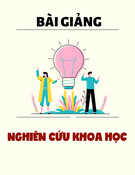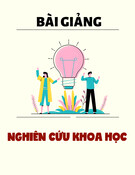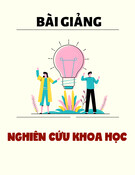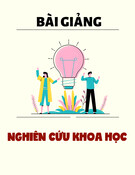
TNU Journal of Science and Technology
229(03): 193 - 201
http://jst.tnu.edu.vn 193 Email: jst@tnu.edu.vn
TEACHERS' ROLES AND CHALLENGES IN DEVELOPING
LEARNER AUTONOMY FOR EFL STUDENTS
Le Van Tuyen1*, Tran Lam Bach2, Tran Kim Hong1
1Ho Chi Minh City University of Technology (HUTECH University)
2Ho Chi Minh City Technical-Economic College
ARTICLE INFO
ABSTRACT
Received:
30/01/2024
EFL teachers play different roles in supporting students’ development of
learner autonomy in their learning. However, they may encounter
challenges in fulfilling their task. This study aims to investigate EFL
teachers’ roles and challenges they may face in developing learner
autonomy for non-English majors at a college in Ho Chi Minh City,
Vietnam. A mixed-methods research design was used. Both quantitative
and qualitative data were collected through the use of questionnaire and
semi-structured interviews. 100 EFL students and 28 EFL teachers
participated in the study. The findings of the study revealed that teachers
implemented various strategies reflecting their four main roles as a
facilitator, counselor, resource provider, and manager in learner
autonomy development for students. The findings also showed that in
the process of developing learner autonomy for students, teachers faced
challenges related to students, teachers themselves, and the learning
environment. The study highlights the teachers’ roles in learner
autonomy development for students and provides recommendations for
teachers and students to enhance the quality of teaching and learning
English in the EFL context.
Revised:
22/3/2024
Published:
22/3/2024
KEYWORDS
Learner autonomy (LA)
Challenges
Teachers’ roles
EFL students
Vietnamese context
VAI TRÒ CỦA GIÁO VIÊN VÀ NHỮNG THÁCH THỨC TRONG VIỆC HỖ TRỢ
NGƯỜI HỌC TIẾNG ANH PHÁT TRIỂN NĂNG LỰC TỰ CHỦ TRONG HỌC TẬP
Lê Văn Tuyên1*, Trần Lâm Bạch2, Trần Kim Hồng1
1Trường Đại học Công nghệ TP. Hồ Chí Minh
2Trường Cao đẳng Kinh tế - Kỹ thuật TP. Hồ Chí Minh
THÔNG TIN BÀI BÁO
TÓM TẮT
Ngày nhận bài:
30/01/2024
Giáo viên có những vai trò khác nhau trong việc hỗ trợ người học tiếng
Anh phát triển năng lực tự chủ trong quá trình học tập. Tuy nhiên, giáo
viên có thể gặp một số những thách thức nhất định trong quá trình hoàn
thành nhiệm vụ của mình. Bài báo có mục đích nghiên cứu vai trò của
giáo viên và những thách thức họ gặp trong quá trình phát triển năng lực
tự chủ cho sinh viên không chuyên Anh tại một trường cao đẳng ở Thành
phố Hồ Chí Minh, Việt Nam. Thiết kế phương pháp nghiên cứu hỗn hợp
được áp dụng cho nghiên cứu này. Dữ liệu được thu thập thông qua bảng
câu hỏi khảo sát và phỏng vấn bán cấu trúc. Có 100 sinh viên và 28 giáo
viên dạy tiếng Anh tham gia vào nghiên cứu này. Kết quả của nghiên cứu
cho thấy giáo viên đóng vai trò là “tư vấn”, “khuyên bảo”, “cung cấp ngữ
liệu” và “quản lý” trong việc phát triển tính tự chủ cho người học. Giáo
viên cũng gặp một số thách thức liên quan tới người học, môi trường học
và chính bản thân họ. Nghiên cứu làm rõ thêm vai trò của giáo viên và
đưa ra những đề xuất giúp giáo viên và sinh viên nâng cao chất lượng
dạy và học tiếng Anh.
Ngày hoàn thiện:
22/3/2024
Ngày đăng:
22/3/2024
TỪ KHÓA
Năng lực tự chủ
Thách thức
Vai trò của giáo viên
Sinh viên học tiếng Anh
Ngữ cảnh Việt Nam
DOI: https://doi.org/10.34238/tnu-jst.9277
* Corresponding author. Email: lv.tuyen@hutech.edu.vn

TNU Journal of Science and Technology
229(03): 193 - 201
http://jst.tnu.edu.vn 194 Email: jst@tnu.edu.vn
1. Introduction
Learner autonomy (LA) has become an increasingly important concept in the field of
English as a foreign language (EFL) education. It is widely recognized that developing LA can
lead to better learning outcomes, increased motivation, and enhancement of our students’
capability to engage in lifelong learning [1]. It is essential to develop LA in language learning
in order to cultivate the skills and knowledge required for learning to continue throughout
learners’ life. Language teachers may successfully encourage LA in their classrooms by using a
variety of instructional tactics, and their roles might also shift depending on how they engage
with their learners. According to Voller [2], a teacher may perform such functions as a
facilitator who initiates and supports decision-making processes or creates a pressure-free
learning atmosphere [3], and creates courses that provide opportunities for learners to develop
academic skills [4]; a counselor who responds to learners’ ongoing needs, a resource provider
who makes knowledge and skills accessible to the learner in times of needs, or a manager who
plans, organizes the process of learning and teaching and assess students according to the
objectives.
Nonetheless, developing LA is a complex and challenging process, and teachers may
encounter several challenges when they attempt to develop LA in their classrooms. According
to Borg and Al-Busaidi [5], challenges in developing LA can be categorized into three major
factors: teacher-related challenges, student-related challenges, and learning environment-
related challenges. Regarding teacher-related challenges, Deci and Ryan [6] identify the
difficulties teachers may face in developing LA due to their limitations. This can include a lack
of autonomy or experience in training learners to become autonomous in learning. Teachers
may also have unreasonable expectations of what learners can achieve, making it challenging
to inspire them to take care of their own learning. Additionally, student-related challenges refer
to students' difficulties in developing LA. For instance, inadequate English proficiency, lacking
motivation, aptitude, or skills to utilize resources or learning methodologies can be a
significant challenge. As Benson and Voller [7] point out, some learners may resist taking
control of their learning because they are used to a more traditional teacher-centered approach
or lack confidence in their abilities or lack motivation in learning. What is more, the learning
environment may also cause teachers challenges in the process of developing LA, such as so
much pressure placed on teachers, being overwhelmed and overloaded with work, prescribed
curricula or lack of relevant resources for both teachers and students like webs, the Internet,
videos, and many other things [8].
So far, many studies have investigated LA in language learning, LA and culture, teachers' and
students' beliefs in LA, and teachers' roles in fostering LA [9] - [13]. Nevertheless, there is still a
need for research, specifically focusing on the roles and challenges of teachers in developing LA
for non-English majored students at colleges in Vietnam.
With the aim of investigating teachers’ roles and challenges encountered in developing LA for
non-English majored students, the above-mentioned four roles of teachers and three challenges
relating to teachers, students and the environment are chosen as the conceptual framework for the
current study. The study made an effort to address two research questions:
a) What are EFL teachers' roles in developing LA among non-English majors at Ho Chi Minh
City Technical-Economic College from students’ perspectives?
b) What challenges do EFL teachers encounter in developing LA among non-English majors
at Ho Chi Minh City Technical - Economic College from EFL teachers' perspectives?
It is expected that exploring EFL teachers’ roles and challenges in developing LA among
non-English majors at a college will certainly contribute to the existing knowledge of this
study field.

TNU Journal of Science and Technology
229(03): 193 - 201
http://jst.tnu.edu.vn 195 Email: jst@tnu.edu.vn
2. Research methodology
2.1. Research site and participants
This study was conducted at Ho Chi Minh City Technical-Economic College (HOTEC) in Ho
Chi Minh City, Vietnam. HOTEC currently trains students in such majors as Economics,
Information Technology, Building management, Fashion Design and English. The total number
of the staff is 245; and there are nearly 4.000 students. English is a compulsory subject with three
levels: English 1, English 2, and English 3 taught in their first, second, and third year
respectively. The goal of the courses is to provide students with English knowledge and ability to
use English for international communication.
Regarding the sample, the study invited two cohorts of participants, including 28 EFL
teachers. Among them, 13 (46.4%) are male and 15 (53.6 %) are female. Their ages range from
24-29 (14.3%), 30-35 (17.9%), 36-40 (35.7%) and 41-over (42.1%). They have taught English
for 2-4 years (3.6%), 5-7 years (21.4%), 8-10 years (28.6%) and 11-over (46.4%). 27 of them
are MA degree holders, and one is a PhD degree holder. The second cohort consists of 100
non-English majored students. 60% of them are male and 40 % are female. Their ages range
from 18-20 (90%), 21-23 (8%), to 27 (2%). Most of them have studied English for 8 years
(59%); 33% for 1-3 years and 8% for 4-7 years. All the students have 9 hours of English per
week at the college.
2.2. Research instrument
The current study employed mixed methods research design, using two research instruments:
the questionnaire and interview for collecting quantitative and qualitative data. Regarding the
questionnaire, two versions of questionnaire were designed to collect data from EFL students and
teachers. The student questionnaire consists of two parts; the first part aims to ask about personal
information such as gender, age, learning experience. The second part with 20 items ( = 0.851)
using a 5-point Likert scale (Never, Rarely, Sometimes, Often, Always) aims to ask about the
teachers' roles in LA development, including four items asking about the role as “facilitator”, five
items asking about the roles as “counselor”, six items asking about the role as “resource
provider”, and five items asking about the role as “manager”. The teacher questionnaire also has
two parts; the first part asks about personal information such as gender, age, qualification, and
teaching experience, and the second part consists of 18 items ( = 0.908) using a 4-point Liker
scale (Strongly disagree, Disagree, Agree, Strongly agree) asking about the challenges
encountered by the teachers in LA development, including seven items asking about student-
related challenges, four items asking about teacher-related challenges, and seven items asking
about learning environment-related challenges. Furthermore, the semi-structured interviews
consisting of eight open-ended questions for asking students about what roles the teachers usually
play to support their EFL learning, and seven questions for asking the teachers about what
challenges they encountered during LA development for students. The interview was used to
collect qualitative data to gain a deeper understanding of the participants' perceptions to support
quantitative data collected from the questionnaires.
2.3. Procedures for data collection and analysis
In terms of data collection, the student questionnaire was piloted with five students who did
not take part in the official study. Following the pilot test, 108 EFL students from four classes of
non-English majors completed the questionnaire within 15 minutes. Due to the irrelevant
completion of the eight questionnaire copies, 100 copies were relevant, so the final number of
student participants was 100. Regarding the delivery of the questionnaire copies to the teachers,
the teachers completed the questionnaire within 15 minutes. No copies were incomplete or
irrelevant, so the total number of teacher participants was 28. For the interviews, ten students and

TNU Journal of Science and Technology
229(03): 193 - 201
http://jst.tnu.edu.vn 196 Email: jst@tnu.edu.vn
five teachers volunteered to join the interviews. Each participant had about 15-20 minutes to
answer the questions. To ensure that all interview data was accurate and comprehensive, every
interview was performed in Vietnamese and meticulously recorded. Besides, an interview sheet
was also used for each participant; the researcher also took particularized notes throughout the
interview procedure.
With respect to data analysis, through SPSS software, “descriptive statistics” was employed to
analyze the quantitative data. Mean (M) and standard deviation (St.D) were calculated. The
meaning of the means (M) scores for students’ perceptions of the roles of the teachers were
interpreted as follows: For research question 1, based on the calculated interval coefficient for
four intervals in five points (5 - 1 = 4), intervals with the range of 0.80 (4/5) were arranged. The
following criteria in the Likert scale were used to interpret the data: never (M = 1.00 - 1.80);
rarely (M = 1.81 - 2.60); sometimes (M = 2.61 - 3.40); often (M = 3.41 - 4.20); always (M = 4.21
- 5.00). For research question 2, intervals with a range of 0.75 (3/4) were arranged based on the
interval coefficient for three intervals in four points (4 - 1 = 3). To interpret the results, the
following Likert scale criteria were used: Strongly disagree: (M = 1.00 - 1.75), Disagree: (M =
1.76 - 2.50), Agree: (M = 2.51 - 3.25) and Strongly agree: (M = 3.26 - 4.00). “Content analysis”
was employed for analyzing data collected from the interviews. The students were coded as S1,
S2, S3… and S10, and the teachers were coded as T1, T2… and T5.
3. Results and discussion
3.1. Results
3.1.1. Teachers' roles in LA development
The data from both questionnaire and semi-structured interviews are displayed in this section.
The data displayed in Table 1 reveal that the teachers effectively developed LA through strategies
or activities reflecting their roles as a facilitator, counselor, resource provider, and manager with
M = 3.99, 3.75, 3.75 and 3.82 and St. D = 0.870, 0.829, 0.826 and 0.866.
Table 1. Descriptive statistics of 4 roles of the teachers
No
Categories
N
M
St. D
1
The Role as “Facilitator”
100
3.99
0.870
2
The Role as “Counselor”
100
3.75
0.829
3
The Role as “Resource provider”
100
3.75
0.826
4
The Role as “Manager”
100
3.82
0.866
Regarding the role as a “Facilitator”, most of the students reported that teachers often “assisted
them in setting their learning goals” with M = 3.78 and St. D = 0.97 and “helped choose materials
for learning” with M = 4.01 & St. D = 0.860. More interestingly, teachers also “assisted students in
self-assessing learning process and progress” with M = 3.84 and St. D = 1.06 and “encouraged
students to reflect on their learning process” with M = 3.92 and St. D = 1.11. Concerning qualitative
data, it was found that most students stated that they received a lot of assistance from their teachers.
For example: “My teacher usually encourages me to take part in English clubs on the internet, to
set goals for my English learning and to choose extra materials to study” S1; “My teacher
recommends materials for me to read. She also instructs me how to set goals for learning the
English subject. She shows me videos to watch and listen to improve my English” S2.
In terms of the role as a “Counselor”, it was revealed that most teachers often acted as a
counselor through the use of 5 strategies, implying that the teachers often paid attention to LA
development for students. More specifically, teachers sometimes “identified psychological
problems that inhibit students’ progress” with M = 3.29 and St. D = 1.17, they often “made students
be aware of the abilities and techniques required for independent learning”, and “discussed with
students to find solutions for their learning difficulties”, “encouraged students to make study plans”

TNU Journal of Science and Technology
229(03): 193 - 201
http://jst.tnu.edu.vn 197 Email: jst@tnu.edu.vn
and they were “positive and supportive, especially when giving feedback” with M = 3.87, 3.71,
3.94 and 3.96 and St. D = 0.97, 1.11, 0.97 and 0.98 respectively. Regarding the qualitative data
gathered from the semi-structured interviews, most students reported that their teachers frequently
assisted them in resolving their issues. For example: “… If you or your friends have problems in
class, the teacher will sit down and point out those points” (S10); “… If I don‟t understand
something during the study, the teacher always helps to discuss the problem at the end of the
lesson” (S3).
With respect to the role as a “Resource provider”, six strategies were investigated. It is
evident that the teachers also supported students in searching for materials for self-study through
which they could develop their LA. Most students reported that their teachers often employed
those strategies for LA development in class. For example, they “suggested self-assessment tools
and techniques for students” with M = 3.45 and St. D = 1.21, “utilized computer-based learning
materials with M = 3.72 and St. D = 1.14, “evaluated materials based on student needs” with M =
3.85 and St. D = 1.04, “recommended resources for English practice outside the classroom” with
M = 3.67 and St. D = 1.16, “encouraged students to read English books, magazines and
newspapers outside the classroom and study with peers” with M = 2.61, 4.20 and St. D = 1.12,
0.090 respectively. Qualitative data also revealed that teachers often provided students with
learning resources inside and outside classrooms, which they found very useful for their
autonomous learning. As illustrated below: “The teacher introduces books and short stories to
the class for reference” (S3); “…She often recommends free English learning websites with
exercises related to that day lessons” (S4).
Concerning the role as a “Manager”, there is evidence that the teachers often employed all
five strategies. The data showed that teachers often “organized classroom games and activities”
with M = 3.41 and St. D = 1.28, “provided clear task instructions to students” with M = 4.05 and
St. D = 1.00, “explained the objectives and significance of the tasks assigned to the students”
with M = 3.92 and St. D = 1.07, “gave opportunities for students to voice their opinions in
classroom management and learning activities” with M = 3.79 and St. D = 1.04, and “gave
opportunities for students to voice their opinions in learning activities” with M = 3.97 and St. D =
1.01. Qualitative data revealed that teachers frequently planned activities for classes. For
example: “My teacher often holds activities using English and calls for us to participate, such as
playing games with the gifts for the winning team” (S2). “The English teacher often organizes
classes with games for me to participate in” (S5). It can be concluded that the data gathered via
the questionnaire and the interviews are comparable, showing that the teachers have developed
LA for their students.
3.1.2. Challenges encountered by teachers in developing learner autonomy
It has been found that EFL teachers encountered those challenges related to students, teachers
themselves and the learning environment.
Regarding student-related challenges, the data showed that the teachers agreed and
strongly agreed with all the seven challenges with mean scores ranging from 3.21 to 3.39.
More specifically, they reported that most students “lacked knowledge and skills to become
autonomous learners” with M = 3.39 and St. D = 0.57. They only “wanted to depend on
teachers in learning English” with M = 3.29 and St. D = 0.60. Especially, they “lacked
motivation to study English” with M = 3.43 and St. D = 0.63. In addition, many students still
could not make decisions in their learning. They consistently “followed the guidance and
judgment of the teachers” with M = 3.43 and St. D = 0.50. Another challenge is that they “did
not have many opportunities to use English outside the classroom” with M = 3.21 and St. D =
0.83. More interestingly, the teachers strongly agreed that the students only “wanted to pass the
exam with high grades”, and “their English proficiency is not very high” with M = 3.32, 3.54
and St. D = 0.61, 0.64 respectively. In terms of qualitative data collected from the semi-



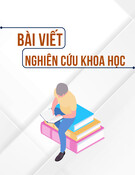
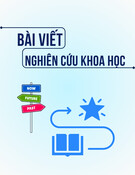
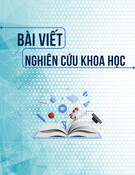
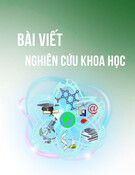
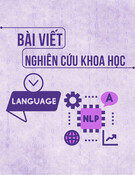






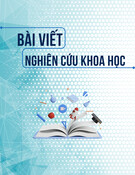

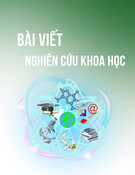

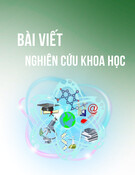


![Định hướng giáo dục STEM trong trường trung học: Tài liệu [chuẩn/mới nhất]](https://cdn.tailieu.vn/images/document/thumbnail/2025/20251124/dbui65015@gmail.com/135x160/25561764038505.jpg)
